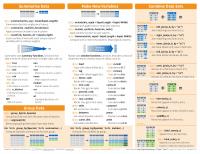Mathematica cheatsheet 0521643147
https://math.ecnu.edu.cn/~jypan/Teaching/MathSoft/refs/Mathematica_CheatSheet.pdf
294 50 107KB
English Pages [2] Year 2012
Using Mathematica like a calculator
Algebra
Calculus
Linear Algebra
Plotting in Mathematica
Mathematica As A Programming Language
Recommend Papers

- Author / Uploaded
- Joe
File loading please wait...
Citation preview
Just Enough Mathematica to Make you Dangerous Joe St Sauver, Ph.D. ([email protected]) Algebra... Use ssh to get to the % prompt
% math In[1]:= Exit
or hit control-d
% math < sample.m > sample.lst % more sample.lst
Leave Mathematica (when you’re ready to!) Run Mathematica commands from sample.m (non-interactively) with output to sample.lst
Using Mathematica like a calculator...
In[1]:= Out[1]= In[2]:= Out[2]=
Expand[(x+y)^2] x2 + 2 x y + y 2 Factor[%] (x + y)2
Mathematica can expand an algebraic expression... or factor it back to a compact form.
In[3]:= Solve[x^2==81,x] Out[3]={{x -> -9}, {x -> 9}}
Find the roots of an equation; note use of == (rather than just =) in writing the equation.
In[2]:= 27.50-11.92 Out[2]= 15.58
Mathematica as a good old calculator... hit ENTER (or shift-ENTER) after each command
In[4]:= Solve[x^2==-4,x] Out[4]= {{x -> -2I},{x -> 2I}}
Imaginary numbers? No problem...
In[3]:= 15! Out[3]= 1307674368000
Large values are no problem; you could even compute 1500 factorial if you wanted to
Mathematica can also solve systems of algebraic equations in multiple variables.
In[4]:= ?Log Log[z] gives the natural logarithm of z (logarithm to base e). Log[b, z] gives the logarithm to base b. In[5]:= Log[10,3453.8] Out[5]= 3.538
Need help with a function? Enter a ? followed by the name of a Mathematica function. Not sure of a function’s name? You can use a * to see possible matches, e.g., ?L*
In[5]:=Solve[{x+y==1,3x+y==2}] 1 1 Out[5]= {{x -> -, y -> -}} 2 2
In[6]:= (4000/23)^3 64000000000 Out[6]= ----------12167 In[7]:= %//N Out[7]= 5.26013 106
Operations done on whole numbers are always represented exactly when possible.
In[8]:= Sin[60 Degree] Sqrt[3] Out[8]= ------2
Function args must be put in square brackets. Trig functions are in radians by default. Want a numeric value? Remember //N Inverse functions? ArcSin[ ]/Degree
In[9]:= Sum[i/(i^i),{i,1,\ Infinity}]//N Out[9]= 1.62847
Numerically evaluate an infinite sum. You can continue long Mathematica commands lines with a \ at the end of a line
In[10]:= BaseForm[223,2] Out[10]//BaseForm= 110111112 In[11]:= 16^^FAE7 + 16^^2C3E Out[11]= 75557 In[12]:= BaseForm[%,16] Out12//BaseForm= 1272516
Convert the value 223 (decimal) to base 2 (binary).
Note that Mathematica functions are case sensitive and begin with a capital letter.
% means “recall the last result” and //N means “provide an approximate numerical result”
Add FAE7 (hex) to 2C2E (hex); output by default is in decimal, but you can then force that output into hex, too, if you like.
Calculus... In[1]:= Limit[x/(Sqrt[x+1]-1),x->0] Out[1]= 2
Evaluate a limit
In[2]:= Dt[x^3+2x,x] Out[2]= 2 + 3 x2
Compute a total derivative
In[3]:= D[(x^2)(y^3)+4y+x+2,x] Out[3]= 1 + 2 x y3
Partial derivatives work the same way
In[4]:= D[x^3+2x,x,x] Out[4]= 6 x
Take the 2nd derivative with respect to x
In[5]:= Integrate[3x^2+2x,x] Out[5]= x2 + x3
Mathematica can also do integrals, just as you’d expect.
In[6]:= Integrate[E^x,{x,0,1}] Out[6]= -1 + E
Definite integral are also easy to evaluate.
In[7]:=






![Comprehensive Python Cheatsheet [1 ed.]](https://ebin.pub/img/200x200/comprehensive-python-cheatsheet-1nbsped.jpg)


